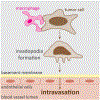Cell Migration Guided by Cell-Cell Contacts in Innate Immunity
- PMID: 33281034
- PMCID: PMC9057246
- DOI: 10.1016/j.tcb.2020.11.002
Cell Migration Guided by Cell-Cell Contacts in Innate Immunity
Abstract
The directed migration of leukocytes to sites of damage or infection is necessary for a productive immune response. There is substantial evidence supporting a key role for chemoattractants in directed migration, however, less is known about how cell-cell contacts affect the migratory behavior of leukocytes in innate immunity. Here, we explore how cell-cell contacts can affect the directed migration of innate immune cells, including their role in attracting, repelling, or stopping cell motility. Further investigation of cell contact dynamics as guidance cues may yield new insights into the regulation of innate immunity.
Keywords: cell–cell contact; macrophages; migration; neutrophils.
Copyright © 2020. Published by Elsevier Ltd.
Figures





Similar articles
-
Convergent and Divergent Migratory Patterns of Human Neutrophils inside Microfluidic Mazes.Sci Rep. 2018 Jan 30;8(1):1887. doi: 10.1038/s41598-018-20060-6. Sci Rep. 2018. PMID: 29382882 Free PMC article.
-
Neutrophils in innate and adaptive immunity.Semin Immunopathol. 2013 Jul;35(4):377-94. doi: 10.1007/s00281-013-0374-8. Epub 2013 Apr 4. Semin Immunopathol. 2013. PMID: 23553214 Review.
-
Neutrophil migration in inflammation: intercellular signal relay and crosstalk.Curr Opin Immunol. 2017 Feb;44:34-42. doi: 10.1016/j.coi.2016.11.002. Epub 2016 Dec 9. Curr Opin Immunol. 2017. PMID: 27951434 Review.
-
Neutrophil chloramines: missing links between innate and acquired immunity.Immunol Today. 1997 Dec;18(12):577-80. doi: 10.1016/s0167-5699(97)01161-4. Immunol Today. 1997. PMID: 9425735
-
The lymph node neutrophil.Semin Immunol. 2016 Apr;28(2):129-36. doi: 10.1016/j.smim.2016.03.008. Epub 2016 Mar 26. Semin Immunol. 2016. PMID: 27025975 Review.
Cited by
-
Lipoxin A4 Receptor Stimulation Attenuates Neuroinflammation in a Mouse Model of Intracerebral Hemorrhage.Brain Sci. 2022 Jan 26;12(2):162. doi: 10.3390/brainsci12020162. Brain Sci. 2022. PMID: 35203926 Free PMC article.
-
Engineered barriers regulate osteoblast cell migration in vertical direction.Sci Rep. 2022 Mar 15;12(1):4459. doi: 10.1038/s41598-022-08262-5. Sci Rep. 2022. PMID: 35292702 Free PMC article.
-
Pannexin Channel Regulation of Cell Migration: Focus on Immune Cells.Front Immunol. 2021 Dec 16;12:750480. doi: 10.3389/fimmu.2021.750480. eCollection 2021. Front Immunol. 2021. PMID: 34975840 Free PMC article. Review.
-
Integration of immune cells in organs-on-chips: a tutorial.Front Bioeng Biotechnol. 2023 Jun 1;11:1191104. doi: 10.3389/fbioe.2023.1191104. eCollection 2023. Front Bioeng Biotechnol. 2023. PMID: 37324438 Free PMC article. Review.
-
[Design, simulation and application of multichannel microfluidic chip for cell migration].Sheng Wu Yi Xue Gong Cheng Xue Za Zhi. 2022 Feb 25;39(1):128-138. doi: 10.7507/1001-5515.202105002. Sheng Wu Yi Xue Gong Cheng Xue Za Zhi. 2022. PMID: 35231974 Free PMC article. Chinese.
References
Publication types
MeSH terms
Grants and funding
LinkOut - more resources
Full Text Sources
Other Literature Sources

